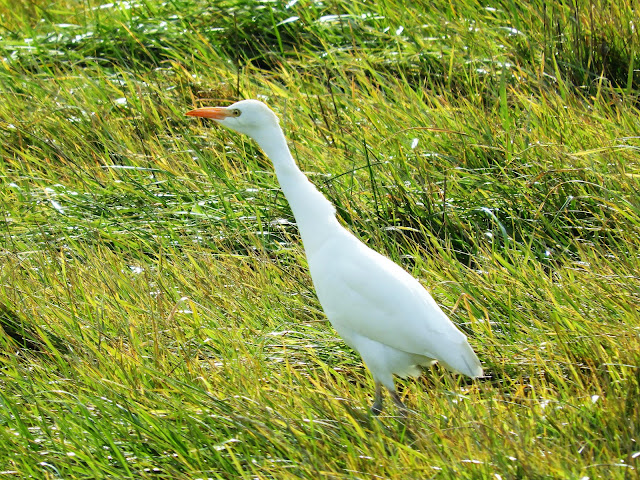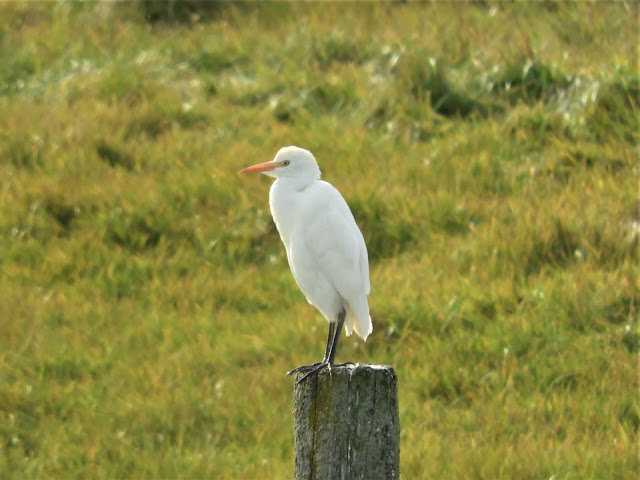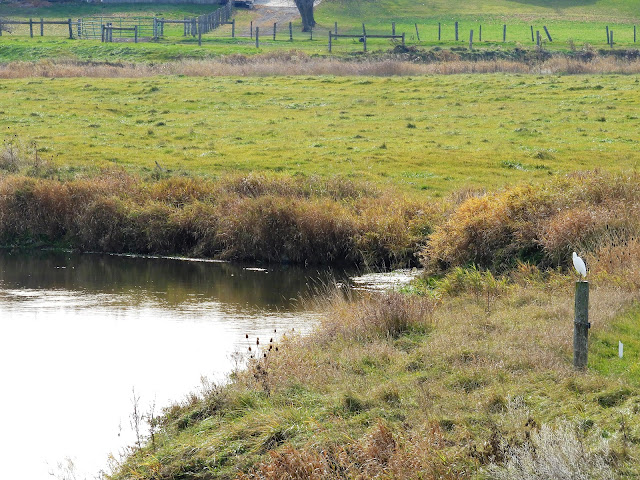This bird appears healthy and has now been present for a little over a week since first being discovered, on 31 October to the best of my knowledge.
The weather has been so uncharacteristically mild of late (yesterday the temperature nudged 20 degrees) that there appears to be an abundance of grasshoppers and other insects even this late in the season, and the bird was feeding successfully.
The only other time that Miriam and I have seen this species in Waterloo Region was on 21 October 2016 on Streicher Line in Wellesley Township. Given the timing of the two sightings, this perhaps indicates some form of post-breeding dispersal.
Cattle Egret has an interesting history of translocation from the grasslands of Africa, where it followed the huge herds of ungulates, to ship-assisted passage to South America, where it quickly became established. Progression northwards occurred almost right away and North America was colonized, to the point where Cattle Egret is now the most numerous heron. As early as 1974 there were over 400,000 birds in the eastern USA alone. (The Herons (2005), Kushlan and Hancock).
Similar colonization has occurred in Europe and Cattle Egrets are being sighted with increasing regularity in Britain. This follows the recent success of Little Egret (Egretta garzetta) in establishing a population there, and Great Egret (Ardea alba) seems destined to follow.
Herons, one might conclude, are avian pioneers!
There has long been taxonomic debate about the eastern and western forms of Cattle Egret. See as follows from The Herons cited above.
"The general placement of Cattle Egret has been uncertain, leading to its being assigned to the pond heron genus, Ardeola, and to its own genus, Bubulcus. The uncertainty was due to difficulty unravelling evolutionary relationships disguised by morphological adaptations to terrestrial foraging. The recognition of the two currently recognized subspecies deserves additional study as their distinct ranges and distinctive plumages, and perhaps body proportions suggest they may be separate species."
To expect uniformity from taxonomists seems to be a bit of a fantasy but the IOC World Bird Names accepted two species, Western Cattle and Eastern Cattle Egret (B. coromandus). See IOC World Bird Names 10.2 for complete lists.
Regardless of the taxonomic niceties and whether you consider this individual a full species or a sub species, it is a splendid visitor to our area, welcomed by bird lovers everywhere, especially those who have never encountered it before.
One wonders, given the proclivity of this species to establish new populations, and the continuing warming experienced in southern Ontario, how long it will take before it becomes a regularly breeding species here. Sooner rather than later would be my guess.






























A bird that I grew up with being almost as common as the sparrow here! I took them for granted when I lived in Africa now I would be very happy to see one close by. Keep safe, Diane
ReplyDeleteHow wonderful to see this egret, wish it would visit Kaiserswerth! Great photos, too! Enjoy your day, hugs, Valerie
ReplyDeleteSince I have been clueless on the many different egrets until I started reading bird watcher blogs, I really don't know what type of egrets I have seen in the past. Many lovely photos and nice information.
ReplyDeleteInteresting a bird that is now ubiquitous in the American South came to us via Africa. Didn’t know there was a western variety so I’m off to study the differences.
ReplyDeleteWhat a treat to see this bird David!
ReplyDeleteSo many birds are avian pioneers. Pioneers with incredible navigation skills, and fortitude beyond my imagining (but not beyond my appreciation).
ReplyDeleteExciting to see such an unusual bird in the area. It’s a beauty!
ReplyDeleteHari OM
ReplyDeleteI do like egrets, since ever I first saw them. All herons have a place in most birders' hearts I suspect! YAM xx
Very nice photos, David. The Cattle Egret is very beautiful.
ReplyDeleteAs you so rightly observe, David, the growth of the egret population in UK has been truly remarkable. 20 years ago, a Little Egret in the county would have been worthy of mention and Great Egret virtually unheard of. Now I could show you a Great Egret to order. However, Cattle Egret, although no longer rare, is still noteworthy - but probably not for long!
ReplyDeleteStay safe - - - Richard
Precioso disfrute de esta garceta amigo mío, ha sido todo un placer poder contemplarle por las bellas fotos, como siempre geniales. Como bien dices David cualquier día de estos se quedan por esos bellos parajes de Ontario y se reproducirá.
ReplyDeleteUn fuerte abrazo de tu amigo y compadre Juan.
Co-incidentally I'm hoping to see Cattle Egrets on my walk tomorrow. In this part of Cambridgeshire Great Egrets now seem to be established and Cattle Egrets are the rarer species. About 25 years ago I travelled down to the south coast, where Little Egrets were causing much excitement; now I can see them just a few hundred yards from my back door. We lose some and gain some, it seems.
ReplyDeleteWhat a pretty bird I have yet to see in my neck of the woods. It has the aura of a soft fluffy pillow.
ReplyDeleteSuch beautiful pictures ~ Enjoy your week!
ReplyDeleteHi David,
ReplyDeleteBeautiful and funny Egret! I see them almost every year now! And it was rather rare!
Beautifully captured!
Regards,
Maria
this is a lovely bird. I have seen it in several countries walking around the legs of cattle or sitting on horseback. I have loved it since the first one I saw. :)
ReplyDeleteNot only a heron fix, an egret no less. Thank you.
ReplyDeleteWOW! What a treat to see this bird! And how beautiful!
ReplyDeleteHappy Tuesday, David!
The bird has very clean feathers.
ReplyDeleteYears ago we never saw egrets here but now we have three species - Little, Great, and Cattle Egrets. It must be to do with climate change - in fact, on our weather report a few days ago it mentioned that we are sharing the same band of warm weather that you are enjoying Canada.
ReplyDeleteNice of it to pay a visit for whatever reason.
ReplyDeleteNice photos too.
Il est joli, oui peut-être qu'avec le réchauffement climatique on en verra plus...
ReplyDeleteD'un côté ce n'est pas très rassurant pour l'avenir.
Bonne journée
Beautiful images captured of this special visitor.
ReplyDeleteHello, David
ReplyDeleteGreat sighting and photos of the Cattle Egret. They are beautiful birds. Take care, enjoy your day!
I love the photo of it stretched out on the post! I've yet to see one here although as you say they are becoming more regularly seen in the UK.
ReplyDeleteHi David.
ReplyDeleteBeautiful this Heron.
Greetings from Patricia.
Beautiful photos David. Sometimes we see one here. The most of the time between cows.
ReplyDeleteEnjoyed reading about your Cattle Egret. See them in passing while driving on the highways sometimes but never at close enough distance to capture in photo. A real treat to see your photos. Have a great week!
ReplyDeleteWhat a beautiful bird! Thanks for the history.
ReplyDeleteBeautiful bird indeed Thanks for sharing, David.
ReplyDeleteHi Both,
ReplyDeleteMost certainly a superb and exciting bird to see, and as you say how the Egrets have spread, I can remember when I was young reports of Little Egrets in the South of England, we are seeing Little and Great Whites in reasonable numbers and only a few weeks ago a Cattle Egret was at Eyebrook Resrvoir, I'm sure it won't be many years before we have them in numbers.
You stay safe, all the best,
John & Veg-
How very interesting, David. Our egrets -- different from this one -- have long gone. I hope yours stay a bit longer for this is so very beautiful. And perhaps she will like it enough to return next year.
ReplyDeleteBeautiful shots!
ReplyDeleteWhat an elegant bird, and what a treat to see it like this. Great photos :)
ReplyDeleteThis is a beautiful bird. I know you were excited to see it!
ReplyDeleteCan you believe I've never taken a photo of a cattle egret? They're as common as sparrows here; in fact, I passed a small flock browsing on the lawn of a grade school this evening as I was driving home from work. I suppose I should pay them more attention! They are pretty things, and they're great fun to see with the cattle. In fact, there was a large flock attending the cattle at the Attwater Prairie Chicken Preserve when I visited. I could have taken a photo of one sitting atop a steer; next time I will.
ReplyDeleteThe first time I ever saw cattle egret was in our first trip to Mexico . Our kids spotted them sitting on the heads of longhorn cattle, just like a perfect picture. Now we see them often in Florida and our travels in the southeast but that first ever sighting was the best,
ReplyDeleteSo cute.
ReplyDeleteNice pictures of the egret David, I don't see these very often here.
ReplyDeleteAlthough there are plenty here, but not in this region.
Greetings Tinie
Hi david,
ReplyDeletewhile weather conditions are changing, birds and other species are enlarging their living environment, I think. We've seen cattle egrets here sometimes and staying here in wintertime.
It's a nice bird, so enjoy while it's there.
Best regards, Corrie
How good to see this bird, a lovely selection of photographs.
ReplyDeleteMany thanks.
All the best Jan
Will this bird survive our cold winter?
ReplyDeleteI expect it will be leaving any day now.
DeleteInteresting history! It adapted very successfully.
ReplyDeletePor aquí hay bastantes, es un ave muy común. Abrazos.
ReplyDeleteHe’s a handsome fellow and looks as if he’s enjoying being the king of the pond
ReplyDeleteThanks David for this information on the cattle egret. We were familiar with seeing many of them when we lived on the VA Eastern Shore on our frequent visits to the Assateague and Chincoteague wildlife areas. They could often be seen hitching a ride on the wild ponies. I was told they also aided in gulping up insects also hitching a ride.
ReplyDeleteI always learn so much from you!
ReplyDeleteSoon it'll be gone, as you say. It'd be good camo for winter, though!
Hi David - thanks ... I enjoyed the history - and loved Miriam's photo of the one on the post with its tuft perkily up ... so pleased you had a happy time seeing it share its time with you before fleeing south. Take care - Hilary
ReplyDeleteHi David,
ReplyDeleteCattle egrets I have seen once in the Netherlands but many times in Africa. In Africa you can see them in the company of buffaloes and rhinos for instance, as you know of course. They are good hunters too. I have seen them catching mice. I can imagine you liked to have seen this bird.
Greetings, Kees
Herons are wonderful birds. I watched them in the Danube Delta in Romania.
ReplyDeleteGreetings.
I didn't know that this species was so abundant in North America and that they were reaching Canada. In Argentina, at least, although it is widespread, but it is not so numerous and I do not always see them, Ardea alba and Egretta thula are more abundant, even others are easier to observe although they are solitary like Ardea cocoi. Some say that as in Africa they migrate south when winter arrives, some individuals migrate south to Patagonia where they then have a hard time or even die. There are records of some cattle herons even in Antarctica!
ReplyDeleteI immediately believe there was a great commotion among the bird watchers.
ReplyDeleteIn the Netherlands we have many Great Egrets, but the Little Egrets are also advancing more. Seeing a cow heron is also quite a phenomenon with us :-))))))
Beautiful series and beautifully presented David :-)
Kind regards, Helma